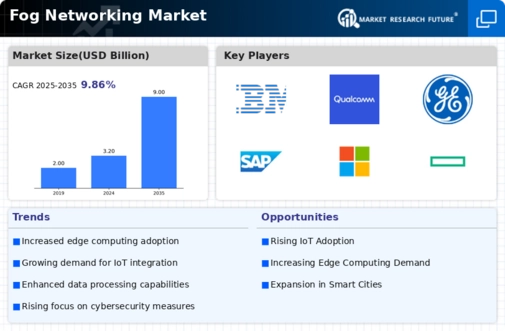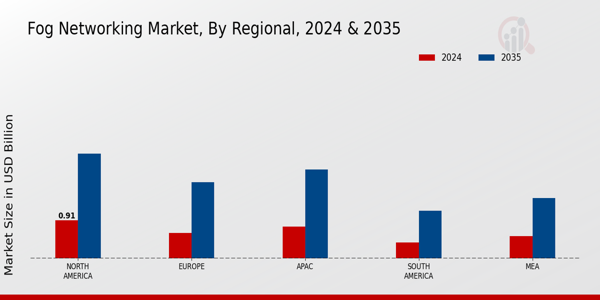Market Growth Projections
The Global Fog Networking Market Industry is poised for substantial growth, with projections indicating a market size of 3.2 USD Billion in 2024 and an anticipated increase to 9 USD Billion by 2035. This growth reflects a compound annual growth rate (CAGR) of 9.86% from 2025 to 2035. Such projections underscore the increasing adoption of fog networking solutions across various sectors, driven by the need for enhanced data processing capabilities and improved security measures. The market's expansion is indicative of the broader trends towards digital transformation and the integration of advanced technologies in everyday operations.
Support for Edge Computing
The integration of fog networking with edge computing technologies is a significant driver for the Global Fog Networking Market Industry. Edge computing allows for data processing at the edge of the network, minimizing latency and improving response times. Fog networking complements this by providing a distributed computing environment that enhances the capabilities of edge devices. As industries increasingly adopt edge computing solutions, the demand for fog networking is expected to rise. This synergy is anticipated to contribute to the market's growth trajectory, with a projected CAGR of 9.86% from 2025 to 2035.
Growth in Smart City Initiatives
The expansion of smart city initiatives worldwide is a notable driver of the Global Fog Networking Market Industry. Governments and municipalities are investing in infrastructure that leverages advanced technologies to improve urban living. Fog networking plays a crucial role in these initiatives by enabling real-time data processing and analytics for applications such as traffic management, waste management, and public safety. As cities become more interconnected, the demand for fog networking solutions is likely to increase, supporting the market's growth. This trend aligns with the broader movement towards sustainable urban development and efficient resource management.
Enhanced Data Security and Privacy
Data security and privacy concerns are increasingly influencing the Global Fog Networking Market Industry. As data breaches and cyber threats become more prevalent, organizations are seeking solutions that provide enhanced security measures. Fog networking offers localized data processing, which can reduce the risk of data exposure during transmission. By keeping sensitive data closer to its source, organizations can implement more robust security protocols. This shift towards secure data handling is likely to drive market growth, as businesses prioritize safeguarding their information assets in an era of heightened cyber threats.
Need for Real-Time Data Processing
The necessity for real-time data processing across various sectors is a compelling driver of the Global Fog Networking Market Industry. Industries such as healthcare, manufacturing, and transportation require immediate insights to make informed decisions. Fog networking addresses this need by facilitating localized data processing, which reduces latency and enhances operational efficiency. As organizations strive to improve their responsiveness and agility, the adoption of fog networking solutions is expected to rise. This trend is indicative of a broader shift towards data-driven decision-making, which is likely to propel the market forward.
Rising Demand for IoT Applications
The increasing proliferation of Internet of Things devices is a primary driver of the Global Fog Networking Market Industry. As organizations deploy more IoT applications, the need for efficient data processing and low-latency communication becomes critical. Fog networking facilitates this by enabling data processing closer to the source, thereby reducing latency and bandwidth usage. In 2024, the market is projected to reach 3.2 USD Billion, reflecting the growing reliance on IoT solutions across various sectors, including smart cities, healthcare, and manufacturing. This trend is expected to continue, with the market potentially reaching 9 USD Billion by 2035.









